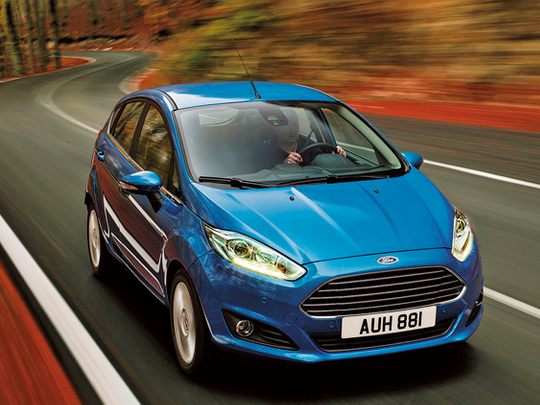
Ford has been on to a winner with the Fiesta for decades. Its engineers always seem to conjure up the right combination of accessibility, user-friendliness, driving dynamics and, recently, efficiency. An update was due, though, and a series of new engines has been added to fresh family styling and some innovative new technologies to make sure that the Fiesta stays top of the supermini pile for a few more years.
The first and most obvious change is that the new Ford front end — first seen on the Evos concept car — has been grafted on to the familiar Fiesta body, with new headlights and, on the whole, a pointier face. Three vibrant new colours have already been announced, too — Copper Pulse, Hot Mustard and Candy Blue. The package is clearly tailored to a younger, more outgoing audience, but all the more reserved colours are there as well.
The engine range includes three turbodiesels and two 1.0-litre turbocharged EcoBoost petrols, with a lower-powered non-turbocharged 1.0-litre three-cylinder petrol rounding off the six. The latter, which produces an impressive 79bhp, is eventually due to replace the 1.25-litre 81bhp four-pot. The four is so old Moses might have had one.
Something very new, however, is the level of technology the Fiesta can hold. B-segment cars aren’t very familiar with comprehensive voice-activation for the stereo, including any connected MP3 players. Nor do many have automated emergency services contact systems that can accurately report the location of the car, wherever this facility is available. The MyKey system is new, allowing parents to apply top speed and audio volume limits among other safety precautions. Some are more useful than others.
Oddly, since most people’s budgets are being heavily squeezed, Ford says that more people than ever are choosing the highest trim levels. As a result there is a new, even higher grade over and above Titanium. Titanium X is the range-topper elsewhere in Ford’s range and now it comes to the Fiesta with partial leather upholstery and heated front seats.
Keyless entry is also new and destined for the X only, although Zetec S and Titanium buyers can add certain X-standard kit as options. Tested here is the higher powered EcoBoost petrol, its turbo-enhanced 999cc pushing out 123bhp and yet sliding under the 100g/km limbo bar. Its power-to-weight figures and the Fiesta’s reputation for handling give it a lot to live up to, and it does so with varying degrees of success.
The three-pot petrol engine is one of many that have been introduced in recent years, but it’s among the coarser, with a few more vibrations than others of its type. It’s also a bit more vocal than most, which given its characterful thrum, is not necessarily a bad thing unless your priorities list is dominated by refinement. The turbo takes only a moment to respond and then delivers really enjoyable acceleration through the five-speed gearbox. It’s a remarkable piece of engineering.
Its ratios are very tall, making it superb for bimbling around town or through the outskirts where speeds rarely rise above 80kph and opportunities to put your foot down are few. Each gear keeps revs low and the unit is one of the main reasons the engine can achieve such high fuel economy. Out of town, though, it soon becomes clear how the tall gearing holds the performance back. Under these conditions the engine needs to be worked harder and fuel economy suffers. A taller sixth gear would be welcome for motorway cruising.
As was seen in the Focus before the Fiesta, the lightweight EcoBoost engine also lightens the front end of the car, giving it an even keener turn-in and letting it hang on to corners even more tenaciously. The effect is less pronounced in the Fiesta because the EcoBoost is only a little lighter than the 1.25-litre petrol it will replace, but the difference between it and the relatively heavy diesels is marked. The petrols are much the sweeter cars to drive, outstripping the competition by a country mile.
Interior quality is subjective according to what the buyer is trading up or down from, but the materials seem solid and they’re given an aesthetic boost with user-selectable colours for the dashboard. Achieving user satisfaction is a multi-layered challenge and more than ever these days the style defines how much people like it. Ford knows what it’s doing. The Fiesta has grown up slightly in some ways, with more technology and better engines. But at its core the same sharp-driving, good-looking supermini favourite remains.












